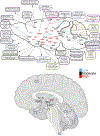Limitations and potential of κOR biased agonists for pain and itch management
- PMID: 38960136
- PMCID: PMC11968146
- DOI: 10.1016/j.neuropharm.2024.110061
Limitations and potential of κOR biased agonists for pain and itch management
Abstract
The concept of ligand bias is based on the premise that different agonists can elicit distinct responses by selectively activating the same receptor. These responses often determine whether an agonist has therapeutic or undesirable effects. Therefore, it would be highly advantageous to have agonists that specifically trigger the therapeutic response. The last two decades have seen a growing trend towards the consideration of ligand bias in the development of ligands to target the κ-opioid receptor (κOR). Most of these ligands selectively favor G-protein signaling over β-arrestin signaling to potentially provide effective pain and itch relief without adverse side effects associated with κOR activation. Importantly, the specific role of β-arrestin 2 in mediating κOR agonist-induced side effects remains unknown, and similarly the therapeutic and side-effect profiles of G-protein-biased κOR agonists have not been established. Furthermore, some drugs previously labeled as G-protein-biased may not exhibit true bias but may instead be either low-intrinsic-efficacy or partial agonists. In this review, we discuss the established methods to test ligand bias, their limitations in measuring bias factors for κOR agonists, as well as recommend the consideration of other systematic factors to correlate the degree of bias signaling and pharmacological effects. This article is part of the Special Issue on "Ligand Bias".
Copyright © 2024 The Authors. Published by Elsevier Ltd.. All rights reserved.
Conflict of interest statement
Declaration of competing interest All the authors declare no conflicts of interest.
Figures


References
-
- Al-Hasani R, et al. , 2017. Circuit dynamics of in vivo dynorphn release in the nucleus accumbens. Alcohol 60, 220.
-
- Appleyard SM, et al. , 1999. Agonist-dependent desensitization of the kappa opioid receptor by G protein receptor kinase and beta-arrestin. J. Biol. Chem. 274, 23802–23807. - PubMed
Publication types
MeSH terms
Substances
Grants and funding
LinkOut - more resources
Full Text Sources
Medical
Research Materials

